The Language of Flowers
The Language of Flowers
Floriography and the British Garden
Floriography, or the language of flowers, was a secret language used to cryptically convey messages. Each flower had its own specific meaning. Upon receipt, they would express feelings which could not be freely spoken.
This grew in popularity, especially during the Victorian era. Strict etiquette prevented the expression of feelings and emotions that may have been considered scandalous. As a result, a more secret way of communicating was called for. However, there is evidence to suggest that flowers have been used to secretly converse for hundreds of years.

Consequently, it doesn't matter whether you love flowers, or you are thinking of planting your own floral garden. Over here at Cultivation Street, we thought to look at some common British flowers and their meanings.
Understanding the different and romantic connotations of these quintessential English blooms could be fun.
There are lots of different ways to learn about history and language, and the way we used to communicate. Why not follow in the footsteps of Victorian schoolchildren and attempt to grow your own garden with meaning? There are plenty of British flowers that will thrive in your school garden!
Bluebell
In Floriography, bluebells symbolise is Humility, Constancy and Gratitude.
This beautiful flower is known by many different names including English bluebell and fairy flower, and they are truly a lovely sight.
‘Constancy’ makes sense, as this flower grows in abundance throughout the UK. In fact, they grow in such quantities in woodlands that ‘Bluebell Woods’ have become a familiar sight.
However, despite the volume of wild common bluebells across the British Isles, the flower is a protected species. Under the Wildlife and Countryside Act of 1981, it is illegal to remove or trade any wild common bluebells.
This is due to the delicacy of their habitats and the leaves and flowers themselves. They can take years to recover from human interference, and the slightest damage can affect their ability to photosynthesis.
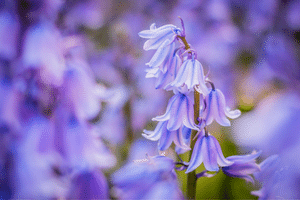
However, you can purchase cultivated Bluebells seeds from your local garden centre.
Make sure to plant them in partial shade, preferably under trees, and in moist but not water-logged soil. They tend to flower in April or May.
Forget-Me-Not
According to Floriography, this flower symbolises True Love and Respect. Most importantly, it embodies the simple but touching plea: Do not forget me.
These delicate little flowers would be perfect for any school garden due to their ability to cluster around each other. They’re also very pretty.
The botanical name is Myosotis. The name originates from the Ancient Greek. This translates to mouse’s ear, in which the tiny fragile petals seem to resemble.
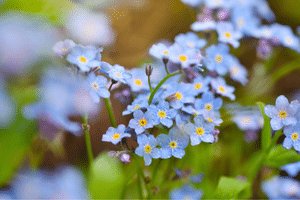
They typically flower in the spring and are a lovely indicator of warmer and more temperate weather.
These sweet and gentle flowers prefer moist habitats, and are often found growing in wetlands, or alongside riverbanks.
Primrose
In the Language of Flowers, the Primrose was closely associated with Youth and Young Love.
It came to mean I can’t live without you.
This is certainly true as, once again, they grow abundantly throughout the UK. The botanical name, Primula, hints at their necessity as it translates to ‘Prime’. This is said to be because they are one of the first plants to flower in spring.
They can be found in open woods, hedgerows, streams and in forests. They are also known to grow alongside motorways and railways, where human interaction is limited or impossible. Once again, the flowers and leaves are fragile.
They have in the past suffered from over-picking and theft, resulting in the flower becoming protected. Much like the common bluebell, to remove or negatively interact with a wild Primrose is illegal.
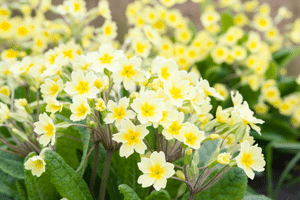
To grow, plant in partial shade, in soil that is moist but well-drained. Some enjoy sun more than others, so keep an eye on them to check for dehydration or difficulty growing. Don’t be afraid to supplement the soil!
Sweet Pea
In Floriography, this means Goodbye or Bittersweet Farewell.
This sweet and fragrant flower was developed in the Victorian era and has since become immensely popular.
As suggested by the name and their subsequent popularity, the flowers and petals are strongly, and sweetly, scented.
In the wild, the flowers are usually a light lilac colour, but can appear in an array of pastel whites, pinks, and blues.
Sow the seeds in cold spring or cold autumn.
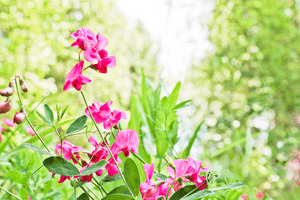
The flowers will start appearing midsummer and continuing for many weeks if looked after correctly. Use bamboo canes or wooden sticks to encourage them to grow straight and tall.
Cornflower
This one is particularly lovely. According to the language of flowers, this flower came to mean Delicacy and Refinement, or Good Fortune.
It makes sense for these flowers to symbolise refinement, due to their elegant and intense shade of blue. They are one of the few truly blue flowers in nature, which makes them somewhat special.
These beautiful blue flowers bloom all summer and require full sun.
In the UK, native cornflowers are on the decline, reduced to just 3 sights where they actively grow in the wild.

These flowers are also edible. They can be used in herbal teas, salads, and desserts. Cornflower petals make a pretty garnish, all thanks to their brilliant blue.
Daisy
English meadows peppered with little white flowers comes to mind whenever we think of daisies. In Floriography, the Daisy came to mean Childlike Innocence.
This is apt, as anyone can attest, due to the temptation to pick and make daisy chains during summer.
The Latin name is Bellis perennis which is thought to mean ‘pretty everlasting.’ This is certainly true. The pretty and delicate flowers have long flowering seasons. They have also been known to appear in mild and temperate winters. The flower is technically a weed.
It has gained the colloquial name Lawn Daisy. This is due to its perchance for growing all over lawns and fields. The actual word ‘daisy’ comes from the Old English ‘Day’s Eye’. This refers to the flowers opening, as if blinking in the morning sun.
Daisies are also edible. Salads and sandwiches are brightened up with this extra foliage. Both the leaves and the flowers can be eaten.
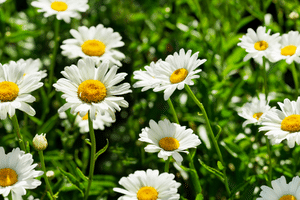
Interestingly enough, that’s not all they can do. Historically, bruisewort or woundwort were more common names. This is due to their healing properties. Cuts, grazes, bruising and even aching muscles were all tended to with the help of this little plant.
You can add daisies to baths and boiling water. This will help heal bruises and tend to sore muscles. So, it’s worthwhile collecting a few before you shred them with your lawnmower or put them in your hair.
Buttercup
Again, this sweet and playful bloom is often flowering in fields and meadows all over England. The Language of Flowers dictates that the Buttercup meant Childishness or Youthful Nature.
You might not think that is a particularly bad connotation. Yet, according to Victorian tradition, to receive a single solitary buttercup was an insult.
The colloquial term buttercup perhaps come from the bright reflective petals in a brilliant shade of yellow. There was once a popular, but also false, belief that the plant was what made butter its signature yellow colour.
Whilst unfounded, this has led to that ever-popular children’s game of collecting buttercups and holding them under the chin to find out if they ‘like butter’.
Once again, the flower is technically a weed.
It will flower in spring. Though sometimes, in the right conditions, they may flower in late summer.
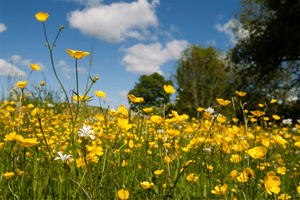
It is perhaps one of the most difficult weeds in the British Isles, notable due to its tough and relentless roots. Though, that doesn't mean you should refrain from planting them or encouraging them to grow. They're still beautiful in their own right, and need little maintenance.
This flower is not edible. It reportedly has a bitter and acrid taste, and definitely won't agree with you. Not even the cows will eat them.
So it's probably best to stick to real butter. Not buttercups.
Daffodil
Finally, we have the daffodil. A symbol for the opening act of spring, this bright yellow flower brings a smile to all who see it.
According to Floriography, the flower came to mean Regard and Unequalled Love.
These flowers can grow in any open space. Specifically woods, grassland, marshes, and riverbanks.
Daffodils flower in early spring, around the Christian holiday of Lent. Therefore, Lent Lily was another common name. The flower has been much celebrated in art and literature. Gardens, parks, and verges all feature this ornamental flower. Many are cut and sold as cut flowers.
Planted in autumn, the bulbs will grow and flower in late winter and will remain until late summer.
The bulbs and the leaves are toxic. Most troublingly, daffodil bulbs bare a striking resemblance to onion bulbs, which can lead to a few culinary mistakes. However, the bulbs do have a bitter and repugnant taste. So, they won't go unnoticed.

When growing daffodils, you may want to consider their medicinal purposes.
An alkaloid extracted from the plant has been used to create a modern drug to treat Alzheimer’s.
Whilst the bulbs and leaves might be acrid and unpalatable, scientists have successfully found a use for the chemicals within it.
It is so interesting to look at flowers throughout our history.
It is clear that flowers have played a crucial part in our culture. Flowers were so important that they had their own language. Understanding how flowers were appreciated over the years can help us understand them better, and give us inspiration when it comes to growing our school garden.

Whilst it might not be as prevalent now, it is still exciting to look at some of the common British plants and their hidden meanings.
It's like learning a new language!
What do you think? What other flowers, or interesting meanings, have you stumbled across? If you'd like to know more, or you've got something to share - let us know in the comments.

